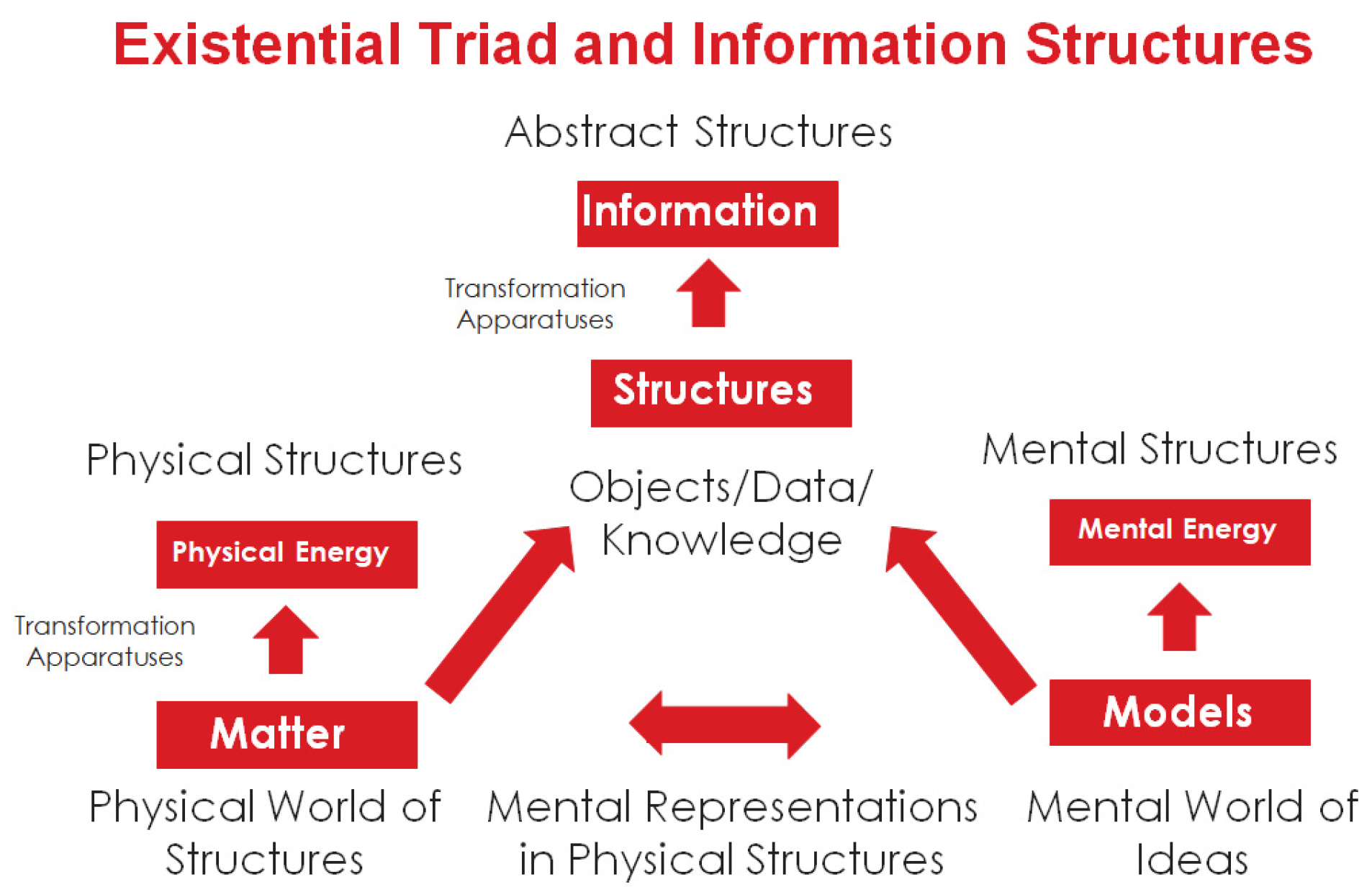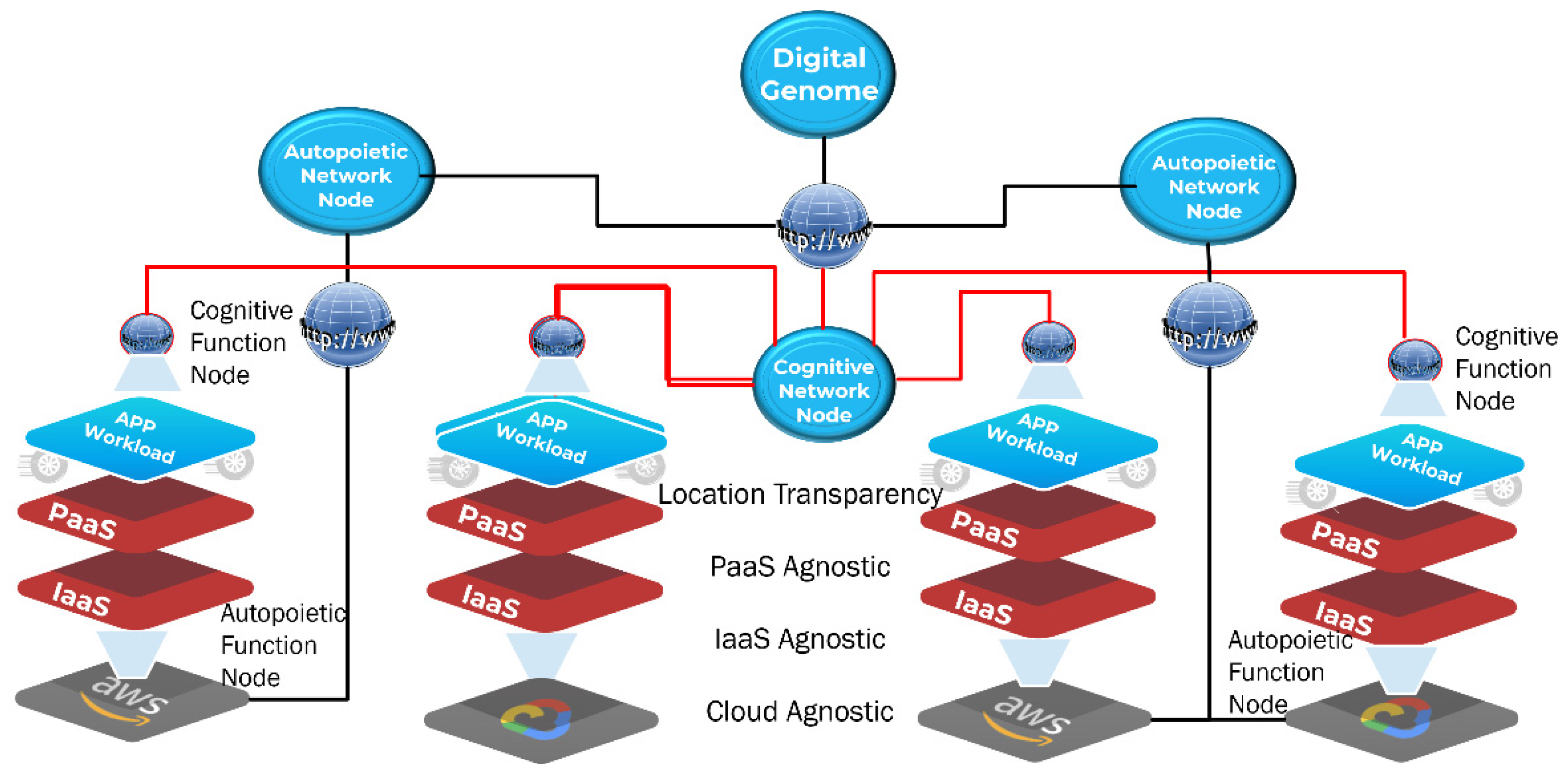1. Introduction
Over millennia, our view of the world has changed from a void with a large number of invisible and indivisible particles, which were called atoms, to a vacuum with vibrating strings in it. We still are trying to grasp Plato’s ideas of forms/ideas with respect to physical reality. Our quest for a better worldview continues.
The general theory of structures (GTS) [
1] offers a vision of the world as a whole in the form of the existential triad. It provides means to model and analyze the physical and mental systems in terms of abstract and ideal structures. Information and knowledge about these structures are related as energy and matter are related to each other, while the transformation rules help us to understand the behaviors of both physical and mental systems.
Figure 1 shows the relationships between these structures.
The primary goal of the general theory of information (GTI) [
2] is “to obtain a definition of information with the following properties. It has to be (1) sufficiently wide to encompass a diversity of phenomena that exist under the common name
information, (2) sufficiently flexible to reflect and organize all properties people ascribe to information, and (3) sufficiently efficient to provide a powerful tool for scientific exploration and practical usage”.
In this paper, we present a scientific exploration and practical use of the tools provided by GTI by examining a complex system where function, structure and fluctuations play key roles in how the system behaves determined by the interactions among its constituent components and their environment. Digital computing structures composed of distributed and communicating software and hardware components fall into this category. A computing structure acts as a complex system where fluctuations in the demand for, and the availability of, resources required to execute the computations disturb its stability and performance. The fluctuations impact on the resiliency and efficiency of the structure grows as the scale of components increases. In addition, when the system is distributed, where the components are concurrent, asynchronous, and locally managed by autonomous infrastructure providers, the emergence of global behavior depends upon the nature and the strength of the fluctuations, and in the case of autopoiesis, is prone to instability. In this paper, we apply GTI tools to a system in which an application deployed in a heterogeneous multi-cloud environment with resources used by the application components is managed by local autonomous infrastructure management systems. We show a way to infuse autopoietic and cognitive behaviors into the application management to predict and manage instabilities by reconfiguring the structure without disrupting the stability of the system. Autopoiesis refers to a system with a well-defined identifier, which is capable of reproducing and maintaining itself. Cognition, on the other hand, is the ability to acquire and process information, apply knowledge, and change the circumstances.
Figure 2 shows a distributed application in a multi-cloud infrastructure.
This paper has the following structure. In
Section 2, we discuss GTI tools and their use for infusing autopoiesis and cognition into application management where the application acts as a self-managing unit with an identifier and manages its own stability with the knowledge of its distributed component deployment and their state of health along with the knowledge of best practices to deal with fluctuations. In
Section 3, we discuss the evolution of application from Turing machine-based algorithms operating on strings of symbols to the structural machines operating on knowledge structures. In
Section 4, we present some conclusions and suggestions for implementing the autopoietic machines with cognitive behaviors.
2. Tools Offered in the GTI
GTI and its various tools that assist in transforming information and knowledge are discussed in detail in the references mentioned here. Here we will briefly review the required tools and discuss their application. An information unit is conventionally described by the existence or non-existence (1 or 0) of a class or object that is physically observed or mentally conceived. The class is an abstract concept with attributes while an object is an instance of a class with an identifier, defined by two components—the object-state and object-behavior. An entity is either an object or a class. An attribute is a key value pair with an identifier (name) and a value associated with it. The attribute state is defined by its value. Information is related to knowledge and is defined by the relationships between various entities and their interactions (behaviors) when the values of the attributes change. A named set or a fundamental triad can represent epistemic connections between two entities as a knowledge structure derived from information (
Figure 3).
A knowledge structure defines various triadic relationships between all the entities that are contained in a system. The knowledge structure is a state or instance of a knowledge schema and various operations are used to evolve the schema from one state to another. Specific instances of the knowledge structure schema are utilized for modeling the domain knowledge and process information changes as they evolve with changes in their entities and their attributes and behaviors.
The structural machine is an information processing mechanism that works with schemas of knowledge structures and performs operations on them to evolve information changes in the system from one instant to another when any of the attributes of any of the objects changes [
3].
The structural machines surpass the Turing machines, which work only with such primitive structures as strings of symbols, by their representations of knowledge and the operations that process information. Triadic structural machines with an assortment of general and mission-oriented processors and other triadic automata enable autopoietic behaviors [
4,
5,
6].
2.1. From Turing Machines to Structural Machines
Structural machines process all kinds of structures including knowledge structures that incorporate domain knowledge in the form of entities, their relationships and process evolution behaviors as a network of networks with each node defining functional behaviors and links defining the information exchange (or communication). The operations on the knowledge structure schema define the creation, deletion, connection and reconfiguration operations based on control knowledge structures. They are agnostic to what the functions of the nodes are or what information is exchanged between them. This provides the composability of knowledge structures across domains in processing information. In contrast, the Turing machines process only strings of symbols, which can encode knowledge for the price of diminishing the efficiency of information processing. Therefore, the Turing machine operations are too simple to support composability across domains causing high complexity in processing information and evolving the knowledge.
2.2. Changing Systems Behaviors Using Functional Communication
The architectural, instructional and behavioral changes are regulated by the knowledge structures and therefore by their impact on knowledge structures, functional communication or information exchange induces the architectural, instructional and behavioral changes. Changes are propagated through knowledge structures, enabling self-regulation of the system.
2.3. Triadic Automata and Autopoietic Behavior
A triadic structural machine with hierarchical control processors provides the efficient and flexible theoretical means for the design of autopoietic automata allowing transformation and regulation of all three dimensions of information processing and system behavior—the physical, mental and structural dimensions. The control processors operate on the downstream information processing structures, where a transaction can span across multiple distributed components by reconfiguring their nodes, links and topologies based on well-defined pre-condition and post-condition transaction rules to address fluctuations, such as fluctuations in resource availability or demand.
2.4. Providing Global Optimization Using Shared Knowledge and Predictive Reasoning to Deal with Large Fluctuations
The hierarchical control process overlay in the design of the structural machine, allows implementing 5E (embedded, embodied, enacted, elevated and extended) cognitive processes with downstream autonomous components interacting with each other and with their environment using system-wide knowledge-sharing, which allows global regulation to optimize the stability of the system as a whole based on memory and historical experience-based reasoning [
7]. Downstream components provide sensory observations and control using both neural network and symbolic computing structures.
These insights allow us to design a new class of information processing systems with higher efficiency, resiliency and scalability in dealing with fluctuations going far beyond the capabilities possible for information processing systems based on the Turing machine model. To achieve these goals, we describe the utilization of this theory for building a self-managing federated edge cloud network deploying autopoietic federated AI applications to connect people, things, and businesses for enabling global communication, collaboration and commerce with high reliability, performance, security, and regulatory compliance. The next section discusses the infusion of autopoietic and cognitive behaviors in the application considered above.
3. Application of the Tools to Design a New Class of Digital Autopoietic Machines with Cognitive Behaviors
Autopoietic machines are built using a knowledge network with knowledge nodes and information sharing links between them. The knowledge nodes are wired together and fire together to manage the behavioral changes in the system [
5,
6,
7]. Each knowledge node contains hardware, software and “infware” that manage the information processing and communication structures within the node. The infware of a system consists of diverse information carriers specifying how to discover, configure, monitor and manage the hardware, software and other infware to maintain their state evolution based on externally infused knowledge such as business requirements dealing with system availability, performance, security, privacy and regulatory compliance. There are three types of knowledge nodes depending on the nature of the infware:
Autopoietic Functional Node (AFN) provides autopoietic component information processing services. Each node executes a set of specific functions based on the inputs and provides outputs that other knowledge nodes utilize.
Autopoietic Network Node (ANN) makes available operations on a set of knowledge nodes to configure, monitor, and manage their behaviors based on the group level objectives.
Digital Genome Node (DGN) is a system-level node that configures a set of autopoietic sub-networks, monitors them and manages them based on system-level objectives.
Each knowledge node is specialized according to its infware defining the knowledge structures that model downstream entities/objects, their relationships and behaviors which are executed using appropriate software, and hardware. The infware contains the knowledge to obtain resources, configure, execute, monitor and manage the downstream components based on the node level objectives.
Figure 4 shows the functional, network and digital nodes with knowledge structures and infware managing various functions that hardware and software provide. There are two network nodes which provide the knowledge structures that manage autopoietic and cognitive behaviors.
The digital genome (similar to a genome in a biological system, which contains the “life” processes and executes the autopoietic and cognitive behaviors using genes and neural networks), contains the “life” processes of the application, and using the knowledge of the available resources in the form of infware, uses the knowledge network to execute various functions. All knowledge nodes are wired together to grant autopoietic and cognitive behaviors.
4. Conclusions
We have proposed an approach using GTI tools to infuse autopoietic and cognitive behaviors for the design and implementation of a self-managing application with the ability to integrate various components and their behaviors to act as a single unit with self-monitoring and self-management capabilities, to maintain stability in the face of fluctuations in a heterogeneous multi-cloud environment. Benefits of this approach include going beyond current techniques, providing an alternative with higher efficiency and addressing both single vendor lock-in and the complexity and tool fatigue of third party-based application orchestration across multiple cloud infrastructures. While application of GTI is in its infancy, there are currently several efforts underway in various laboratories and startups to apply the GTI in various domains.










